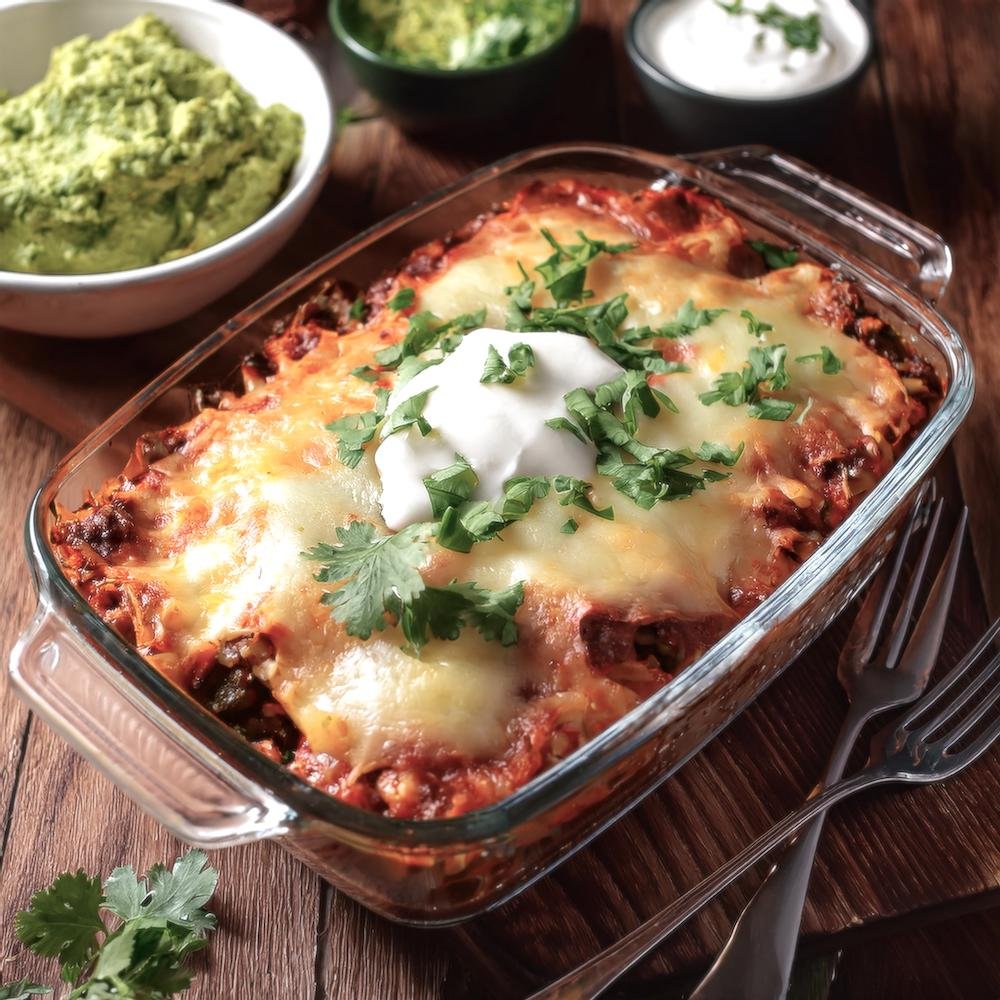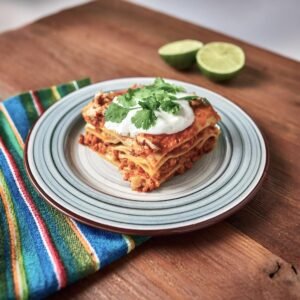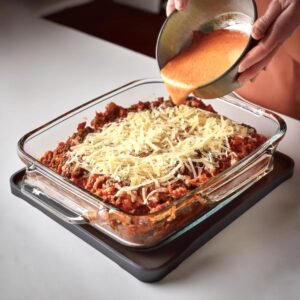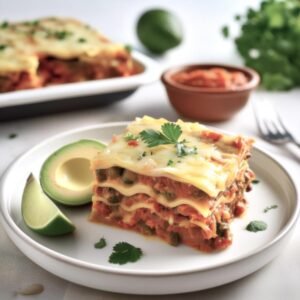What Is Mexican Lasagna Made Of? is a delightful fusion dish that combines the comforting layers of traditional Italian lasagna with bold, zesty flavors inspired by Mexican cuisine. It swaps out pasta sheets for tortillas, incorporates rich, spiced fillings like seasoned meat, beans, and corn, and tops it all off with melted cheese and vibrant toppings.
This dish has become a favorite for families and gatherings because of its versatility and easy preparation. Whether you’re making a quick weeknight dinner or serving a hearty meal for guests, Mexican lasagna offers a flavorful twist on the classic layered casserole.
In this article, we’ll explore what makes Mexican lasagna unique, the core ingredients that define it, and how to customize it to suit your taste.
What Is Mexican Lasagna?
Mexican lasagna is a reinterpretation of lasagna using ingredients commonly found in Mexican cuisine. Instead of pasta, it uses tortillas to create the layers, and instead of Italian marinara or béchamel sauce, it’s made with enchilada sauce or salsa.
How It Differs from Traditional Lasagna
- Tortillas Instead of Pasta:
- Mexican lasagna uses flour or corn tortillas to create the dish’s layered structure.
- The tortillas absorb flavors from the sauces and fillings, making them soft and flavorful.
- Bold Mexican Flavors:
- The filling often includes spiced ground beef, chicken, or beans, paired with enchilada sauce or salsa for a rich, zesty taste.
- Toppings:
- Unlike traditional lasagna, Mexican lasagna is typically topped with fresh ingredients like sour cream, guacamole, and cilantro, adding a burst of freshness.
- Cheese Variety:
- While Italian lasagna focuses on ricotta, mozzarella, and Parmesan, Mexican lasagna incorporates cheddar, Monterey Jack, or queso fresco for a more tangy and creamy flavor.
Core Ingredients of Mexican Lasagna
Mexican lasagna is a dish that thrives on bold, flavorful ingredients layered to perfection. Here’s a breakdown of its essential components:
Tortillas
- Role in the Dish:
- Tortillas replace traditional pasta sheets, acting as the foundation for the layered structure.
- They absorb flavors from the sauces and fillings, becoming soft and delicious after baking.
- Types of Tortillas:
- Flour Tortillas: Commonly used for their pliability and neutral flavor.
- Corn Tortillas: Ideal for gluten-free versions and a more traditional Mexican taste.
Pro Tip: Lightly toast the tortillas before layering to prevent them from becoming overly soggy.
Meat
- Seasoned Ground Meat:
- Ground beef or ground turkey is the most common choice, cooked with taco seasoning for a zesty flavor.
- Shredded Chicken:
- Slow-cooked or rotisserie chicken, shredded and mixed with sauce, works well for a lighter option.
- Vegetarian Alternatives:
- Black beans, pinto beans, or lentils can replace meat entirely for a plant-based version.
Pro Tip: Cook the meat with onions, garlic, and a dash of chili powder or cumin to enhance the flavor.
Cheese
- Cheese Choices:
- Cheddar and Monterey Jack: The go-to cheeses for Mexican lasagna, offering a creamy and slightly tangy flavor.
- Queso Fresco or Cotija: Used as a topping for an authentic Mexican touch.
- Layering Cheese:
- Shredded cheese is sprinkled between the layers and on top to create a gooey, bubbly crust during baking.
Pro Tip: Use a mix of cheeses for a balanced combination of flavor and texture.
Sauces
- Enchilada Sauce:
- A rich, spiced tomato-based sauce that ties all the ingredients together.
- Choose mild, medium, or spicy based on your heat preference.
- Salsa:
- Salsa can replace or complement enchilada sauce, adding freshness and acidity.
Pro Tip: Use homemade enchilada sauce or salsa for a deeper, fresher flavor.
Beans and Corn
- Beans:
- Black beans or refried beans are a staple in Mexican lasagna, adding protein and texture.
- They’re layered between the tortillas and meat mixture for extra heartiness.
- Corn:
- Sweet corn kernels provide a touch of sweetness that balances the spiced flavors.
Pro Tip: Use roasted or fire-grilled corn for a smoky flavor.
Toppings for Mexican Lasagna
The toppings are where Mexican lasagna truly shines, adding fresh flavors, color, and texture to the dish. These final touches not only elevate the presentation but also enhance the taste.
Common Toppings
- Sour Cream
- Adds creaminess and balances the spiced flavors of the dish.
- Serve it dolloped on top or as a side for individual portions.
- Guacamole or Sliced Avocado
- Offers a rich, creamy texture and a fresh contrast to the bold, baked flavors.
- Guacamole adds zest, while avocado slices provide a mild, buttery element.
- Chopped Cilantro
- Adds a bright, herbal note that complements the rich, cheesy layers.
- Sprinkle generously over the top just before serving.
- Diced Tomatoes or Salsa
- Fresh tomatoes or a spoonful of salsa add acidity and a pop of color.
- Great for those who enjoy a bit of extra freshness in each bite.
Spicy Garnishes
- Sliced Jalapeños
- Perfect for those who love a bit of heat. Use fresh slices for a crunchy texture or pickled jalapeños for a tangy kick.
- Hot Sauce
- Drizzle your favorite hot sauce over the lasagna for an extra layer of spice.
Pro Tip: Offer spicy toppings on the side to cater to varying heat preferences.
Cheese and Crunch Additions
- Extra Cheese
- A sprinkle of crumbled queso fresco or cotija cheese adds a tangy, salty flavor.
- Melty cheeses like Monterey Jack can be added right after baking for a gooey finish.
- Tortilla Chips or Crushed Corn Chips
- Add a crunchy topping for textural contrast.
- Use plain or lightly salted chips to avoid overpowering the other flavors.
How to Customize Toppings
- For a Fresh Touch:
- Add shredded lettuce, diced red onion, or a squeeze of lime juice for a refreshing contrast.
- For a Creamier Finish:
- Include a drizzle of crema or plain Greek yogurt as a lighter alternative to sour cream.
- For a Festive Look:
- Garnish with colorful ingredients like sliced bell peppers or edible flowers for a vibrant presentation.
Pro Tip: Set up a toppings bar so everyone can customize their own portion of Mexican lasagna to their liking.
Step-by-Step Guide to Making Mexican Lasagna
Creating Mexican lasagna is easy and rewarding. With its simple layering process and bold flavors, this dish is perfect for beginners and seasoned cooks alike. Follow these steps to make a delicious Mexican lasagna at home.
Step 1 – Gather Your Ingredients
- Essential Ingredients:
- 10–12 flour or corn tortillas
- 1 lb ground beef, turkey, or shredded chicken
- 1 packet taco seasoning (or homemade seasoning)
- 1 cup enchilada sauce or salsa
- 1½ cups shredded cheese (cheddar, Monterey Jack, or Mexican blend)
- 1 cup black beans (optional)
- 1 cup corn kernels (optional)
- Optional Toppings:
- Sour cream, guacamole, chopped cilantro, or diced tomatoes.
Pro Tip: Prepare all ingredients ahead of time to streamline the cooking process.
Step 2 – Preheat the Oven and Prepare the Baking Dish
- Preheat the Oven:
- Set your oven to 375°F (190°C).
- Grease the Dish:
- Lightly grease a 9×13-inch baking dish with oil or nonstick spray to prevent sticking.
Pro Tip: Line the dish with parchment paper for easy cleanup.
Step 3 – Cook the Filling
- Cook the Meat:
- In a skillet over medium heat, cook 1 lb of ground meat or shredded chicken until browned.
- Add Seasoning:
- Stir in taco seasoning and ½ cup water. Simmer for 3–5 minutes until the liquid reduces and the flavors meld.
- Incorporate Add-Ins:
- Mix in black beans and corn if desired, stirring until evenly combined.
Pro Tip: For extra flavor, sauté diced onions and garlic with the meat.
Step 4 – Assemble the Lasagna
- Base Layer:
- Spread a thin layer of enchilada sauce on the bottom of the baking dish.
- First Tortilla Layer:
- Place 2–3 tortillas in the dish, overlapping them slightly to cover the base.
- Add the Filling:
- Spread a layer of the meat mixture evenly over the tortillas.
- Cheese and Sauce:
- Sprinkle a layer of shredded cheese, then drizzle enchilada sauce or salsa over the filling.
- Repeat Layers:
- Add another layer of tortillas, meat, cheese, and sauce, repeating until all ingredients are used.
- Top Layer:
- Finish with a layer of tortillas, sauce, and a generous sprinkle of cheese for a bubbly, golden crust.
Step 5 – Bake the Lasagna
- Cover and Bake:
- Cover the dish with foil and bake for 20 minutes to retain moisture.
- Uncover and Finish:
- Remove the foil and bake for an additional 10–15 minutes until the cheese is melted and golden.
Pro Tip: Lightly oil the underside of the foil to prevent it from sticking to the cheese.
Step 6 – Rest and Serve
- Rest:
- Allow the lasagna to rest for 10 minutes after removing it from the oven. This helps the layers set, making it easier to slice.
- Slice and Garnish:
- Cut into squares and garnish with your favorite toppings like sour cream, guacamole, or cilantro.
Pro Tip: Serve with a side of tortilla chips, salsa, or a fresh salad for a complete meal.
Variations and Substitutes
Mexican lasagna is a versatile dish that can be tailored to fit different dietary preferences or creative twists. Here are some popular variations and substitutes to try.
Gluten-Free Mexican Lasagna
- Corn Tortillas:
- Replace flour tortillas with corn tortillas for a naturally gluten-free option.
- Gluten-Free Sauces:
- Use gluten-free enchilada sauce or salsa. Check labels to ensure no hidden gluten ingredients.
Pro Tip: Toast corn tortillas lightly before layering to prevent sogginess.
Vegetarian Mexican Lasagna
- Replace the Meat:
- Use black beans, pinto beans, or lentils as the main protein source.
- Add roasted vegetables like zucchini, bell peppers, or mushrooms for extra flavor and texture.
- Extra Cheese Layers:
- Layer with additional shredded cheese or queso fresco for richness.
Pro Tip: Sauté vegetables with taco seasoning to enhance their flavor.
Vegan Mexican Lasagna
- Dairy Substitutes:
- Use vegan cheese alternatives like cashew-based cheese or plant-based mozzarella.
- Replace sour cream with coconut yogurt or a vegan crema.
- Egg-Free Tortillas:
- Choose egg-free tortillas to ensure the dish is fully plant-based.
- Sauce Choices:
- Use tomato salsa or a dairy-free enchilada sauce for bold flavors.
Pro Tip: Add nutritional yeast to the cheese substitute for a savory, cheesy flavor.
Spicy Mexican Lasagna
- Add Heat to the Sauce:
- Use a spicy enchilada sauce or mix in chipotle peppers for a smoky kick.
- Jalapeños and Hot Sauce:
- Layer sliced fresh or pickled jalapeños between the tortillas. Add a drizzle of hot sauce for extra spice.
Pro Tip: Sprinkle cayenne pepper or crushed red pepper flakes over the cheese layer.
Creative Variations
- Breakfast Mexican Lasagna:
- Replace the meat with scrambled eggs and breakfast sausage. Use queso fresco and salsa verde for a morning twist.
- Seafood Mexican Lasagna:
- Use shrimp or crab mixed with a creamy sauce for a unique flavor combination.
- Dessert Mexican Lasagna:
- Swap tortillas for sweet crepes or cinnamon-dusted flour tortillas. Layer with chocolate, caramel, and whipped cream for a decadent dessert.
Quick Substitutes for Ingredients
- Tortillas:
- Use thinly sliced sweet potatoes or zucchini as a low-carb alternative to tortillas.
- Cheese:
- Swap traditional cheese for Greek yogurt mixed with nutritional yeast for a tangy flavor.
- Meat:
- Shredded rotisserie chicken is a quick replacement for ground meat.
Pro Tip: Mix and match variations to create a dish that suits your taste and dietary needs perfectly.
FAQs “What Is Mexican Lasagna Made Of?”
What is the Difference Between Mexican Lasagna and Lasagna?
Base Layers: Mexican lasagna uses tortillas as the base, while traditional lasagna uses pasta sheets.
Flavor Profile: Mexican lasagna incorporates bold, zesty flavors like taco seasoning, enchilada sauce, and beans, whereas traditional lasagna features Italian flavors with marinara sauce, ricotta cheese, and herbs.
Toppings: Mexican lasagna is often topped with sour cream, guacamole, and cilantro, while traditional lasagna focuses on melted cheese and sometimes béchamel sauce.
Key Difference: Mexican lasagna is a fusion dish that takes inspiration from Mexican cuisine, while lasagna is a traditional Italian dish.
What Is Traditional Lasagna Made Of?
Pasta: Wide, flat sheets of lasagna noodles, either fresh or dried.
Sauce: A meat-based ragù or marinara sauce, often slow-cooked for depth of flavor.
Cheese: A mix of ricotta or béchamel, mozzarella, and Parmesan for creamy and cheesy layers.
Optional Add-Ins: Spinach, mushrooms, or sausage can be included for variety.
Pro Tip: In northern Italy, traditional lasagna often features béchamel sauce, while southern versions lean on ricotta and tomato-based sauces.
What is the Difference Between Lasagna and Lasagna al Forno?
Lasagna: Refers broadly to the dish, whether it’s baked or unbaked, and includes various global adaptations.
Lasagna al Forno: Specifically refers to lasagna that is baked in the oven, resulting in a firm texture and a golden, bubbly crust.
Key Difference: The term “al forno” emphasizes the baking process, which is a hallmark of traditional Italian lasagna.
How Many Calories Are in Mexican Lasagna?
The calorie count for Mexican lasagna depends on the ingredients and portion size, but here’s a general breakdown:
Standard Serving: A single serving (about 1/8 of a 9×13-inch dish) typically contains 300–450 calories, depending on the amount of cheese, meat, and sauce used.
Lower-Calorie Options: Using lean ground turkey, low-fat cheese, and corn tortillas can reduce the calorie count to around 250–350 calories per serving.
Higher-Calorie Versions: Adding extra cheese, sour cream, or fatty meats can raise the calorie count to 500 calories or more per serving.
Pro Tip: For an accurate calorie count, calculate based on the specific brands and quantities of ingredients you use.
Suggested Internal Links:
- Beef Chuck Eye Steak
Pair your Mexican lasagna with a juicy, flavorful steak for a hearty meal. - What is the Difference Between Lasagna and Lasagna al Forno?
Compare the nuances between traditional Italian lasagna and its Mexican-inspired counterpart. - Garlic Parmesan Chicken Pasta
Complement the bold flavors of Mexican lasagna with a creamy pasta side dish. - What’s the Best Way to Cook Chuck Eye?
Discover techniques to prepare a tender steak that can be served alongside Mexican lasagna. - What Are the Five Mistakes to Avoid Pasta Salad?
Learn tips for making the perfect pasta salad, a refreshing accompaniment to Mexican lasagna.
Conclusion
Mexican lasagna is a flavorful and versatile dish that brings together the comforting layers of lasagna with the bold and zesty flavors of Mexican cuisine. By swapping pasta sheets for tortillas and incorporating ingredients like enchilada sauce, taco-seasoned meat, and cheese, this fusion recipe creates a unique, crowd-pleasing meal perfect for any occasion.
Whether you prefer a vegetarian version, need a gluten-free alternative, or want to spice things up with extra jalapeños, Mexican lasagna offers endless opportunities for customization. With its vibrant toppings and easy preparation, it’s no wonder this dish has become a family favorite.
Now that you know what Mexican lasagna is made of and how to make it, it’s time to try this delicious recipe at home. Get creative with your ingredients, layer it up, and enjoy a hearty meal that’s bursting with flavor. Happy cooking!
Discover more mouthwatering recipes on our Web Site ! Stay connected and get inspired by following us on Facebook, Instagram, Pinterest, and Twitter for the latest updates!




